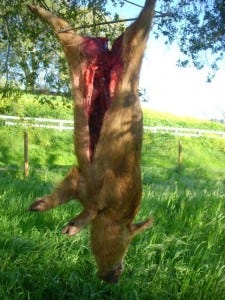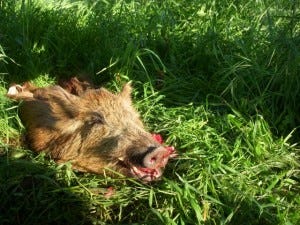What A Boar
I am standing underneath a scarred, ancient oak tree on an isolated ranch far to the west of Paso Robles, in central California, with a dead body, a blond woman, and a strange man—I first laid eyes on him five minutes ago—who is holding a very, very sharp knife.
"It's a surgical blade," he says, with disarming cheer. It looks like a switchblade, to me. An ominous grumbling sound intrudes on the eery stillness of the sunny afternoon.
It's coming from my stomach—I'm hungry.
The dead body is a 200-pound wild boar, the man is a hunter, and the blond woman is Mary Baker, of Central Coast Wine Blogs; she has opened doors for me in this wine community that I might otherwise have spent months—if not years—knocking on. In the next few hours, I will realize several things: I am not squeamish, the boar is destined to grace my table, and hunting wild animals requires patience and a skill-set I shall probably never possess. I also discover that riding a 3-seat, all-terrain-vehicle at blistering high speed down almost-vertical slopes, fishtailing through viscous and darkly muddy gulches, and ranging across the softly rolling, emerald green and oak-studded hills of a Central California magic hour is an activity from which I was mistakenly separated at birth.
I love this place with a fierceness like a lion's, for her cub. And the prospect of many wild boar feasts makes me lick my lips and start mentally reviewing the possible repasts: civet, a riot of braises, "Drunken Boar", a Paso Robles version of cassoulet (Passoulet?). I could get used to this lifestyle, and seriously hope to. But the fact that I'm not a hunter, and likely never will be, causes me nary a worry. Because the handsome, grinning man-with-a-knife—Matt Tupen—is a twenty-year veteran of the hunt—he first accompanied his father hunting in Hawaii at the age of five.
Matt has taken off from his day job—as a paramedic and father of four, in Ventura—to take me hunting on the stunningly beautiful Dubost Ranch, a 320-acre corner of California that grows cattle, barley, safflower, walnuts, persimmons, and wine grapes—and makes highly respected wine. He's been hunting in this area for twenty-years, and yet his sparkling eyes betray an abiding excitement for the chase, as well as profound reverence for the land and the animals that range upon it. His "day job" allows him the flexibility to work as a hunting guide, and his wide-ranging relationships with local ranch owners let him cherry-pick the spot according to his time-honed instincts. Eighty percent of his customers return to hunt with him again, and I can understand why.
"On the other side of those mountains," Matt points toward the western horizon, where magic hour is just starting to mellow the light to soft honey, "the Santa Lucia range, is the Hearst castle. Many of the wild boar in this area are descended from German black pigs, escaped from the castle's breeding program, as well as Eurasian pigs brought by immigrants who settled on the Central Coast in the 1800's." In fact, he says, all wild boar in California are domesticated pigs gone feral, like house-cats a generation or two away from the cosy hearth. I eye the rather prehistoric being hanging in the tree—elongated, covered with coarse hair, tusked—and compare it to the pink, hairless hogs that were ubiquitous as table-breeders before we re-discovered the tasty breeds of yore: the Berkshire, the Tamworth, the Duroc. In fifty years (countless generations, from a pig's point of view), a sort of hyper, reverse-evolution has changed these animals almost beyond recognition. The hindquarters are slimmer, the forequarters heavier (the result of a super-thick shoulder-plate, designed for fighting). The hair is longer and darker, the legs shorter. The snout has become elongated, the fat-cap and marbling—results of a far more relaxed lifestyle—are almost nonexistent. Scientists say such profound changes take only a couple of generations. It's warp-speed adaptability.
Although we do not actually shoot a boar on our hunt (Matt was worried we might not, so he took down our furry friend late on the previous night), I can see that hunting—for this outdoorsman, anyway and, by definition, his clients—is about as far from shooting ducks in a barrel as you can get. For one thing, the State of California places strict restrictions on the hunt, and even though we are far from anyone who'd conceivably object if rules were broken, I get the impression that no true pro would be caught dead stepping outside the boundaries. The pigs tend to come out only after dark, but you are only allowed to shoot them before sunset. You need a California Pig Tag for every animal you plan to take (they're available for a nominal fee at any sporting goods store). The meat is always eaten, and with relish: this is no trophy sport. Any responsible hunter kills only what he/she and their family and friends will consume. You are cheek-by-jowl with the age-old cycle of death and nutrition, here.
Matt cautions me and Mary (both breathless at this far from quotidian adventure) that once the ATV comes to a halt we must keep very still, and very quiet. As the ATV barrels down a precipitous incline, spraying mud, we try to quench our girly squeals of glee, jabbing one another in the ribs while shout-whispering "Shhhhhhh!!!" For Matt, this is no joy-ride: His eyes are darting quickly back and forth from hillock-top to ravine-bottom, binoculars at the ready, and he spots wild turkeys, deer, and coyotes that I would surely have missed. But today, no boar.
Back at the ranch, our stand-in boar awaits. He is not going anywhere, except to dinner, with us. So, too, waits a large but delicate glass of Dubost's 2008 Alexandrine, a luscious blend of Viognier and Roussane that expertly expresses the very soil with which we have just become so intimate.
We gaze into it's golden depths and lift our glasses to life, and death, and dinner.
Matt Tupen, of Tupen Outdoors, can be reached at 805-402-6137 or borrhunter@roadrunner.com. He shoots, usually at long-range, with a Winchester.






